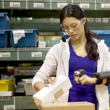

The influx of wireless connectivity, machine-to-machine (M2M) communications and the Internet of Things (IoT) has had dramatic effects on individuals’ lifestyles and the day-to-day operations of companies. For the public sector and increasingly, many in the private sector, connectivity is also improving the well being of the communities being served, writes Hubert Da Costa, the vice president of EMEA at Cradlepoint. (more…)
August 12, 2016
Posted by: George Malim

New research findings suggest that 78% of UK consumer technology and hardware vendors expect the Internet of Things (IoT) to have a significant impact on their ability to gather customer insight data across the supply chain. (more…)
August 11, 2016
Posted by: Avadhoot Patil

From smart thermostats to fitness trackers the race is on for companies to put out the next big connected product. However, during this foundation stage it’s essential that the companies developing or selling IoT technologies don’t take shortcuts when it comes to security protocol and ensure that the products they are selling do not pose any risk to the user’s security, writes Thomas Fischer, the principal threat researcher at Digital Guardian. (more…)
August 10, 2016
Posted by: George Malim

As is the case with so many industries in the current climate, digital is taking over. The demand for real-time information, sourced quickly, easily and where necessary reported in a way that allows for instantaneous analysis is changing the world, and not just in business but also sport. (more…)
August 9, 2016
Posted by: George Malim

The wow factor has played a major role in the public’s perception of the Internet of Things or IoT, writes Jonathan Duffy, the EMEA managing director of Netclearance. There’s something about the idea of a world made up of objects all linked together that resonates with people, so it is understandable that there is currently a lot of hype surrounding it. (more…)
July 28, 2016
Posted by: George Malim

In the past, warehouse workers, otherwise known as pickers, would worth with lists and manually run a warehouse. This took pickers a long time to get shipments in order just and this laborious practice soon became outdated when digital advanced, writes Suzanne Vallance, who works for Ferrari Packaging, a wholesale packaging supplies company based in Scotland.
IoE practices in warehouses
Warehouses have started to use the Internet of Everything (IoE), robotic systems which makes the working day much more effective. IoE and voice picking have improved the efficiency of warehouse practices. Sensors can now even detect everything through a robotic system and businesses can check where their pallets are, whether that is in the warehouse or en route to the shipping dock.
Progressively, businesses are adapting to IoE technology and are connecting the different departments in their organisation. These warehouses, like new technology that we use every day, are called “smart warehouses” and have increased productivity across the board.
IoT and cloud software for business
Cloud software is continuing to develop and change security perceptions. Steve Banker from Forbes Online has stated that there are benefits of using IoT in warehouses and has highlighted how pickers are management are adjusting to the change: “Most well run warehouses have a Warehouse Management Systems (WMS) that depends upon bar code data. Warehouse floor level operations personnel and warehouse managers execute their tasks based upon this data.”
This is true, figures from 2015 have shown the growth of IoT in business, especially in the use of cloud technology:
Cloud software is hosted elsewhere, virtually and businesses manage their accounts by accessing the software over the internet. Organisations will be charged a cloud fee, however, this includes hosting services.
What is a voice picking cloud?
The main method of internet picking is through a voice picking cloud solution. This means organisations can host their information remotely.
This is beneficial as it means your business does not have to obtain, install or maintain servers. This will not only improve staff efficiency in the long run but it will cut costs. In-house IT hardware can be problematic when it comes to continual security and maintenance.
Argos is just one of the UK’s multichannel retailers that have moved away from paper trail picking. This has been beneficial to the company as they claim it has boosted staff productivity and accuracy.
Getting it right the first time is now more important than ever as the fast delivery pressure from the “Amazon effect” is hitting the retail business. Thankfully for Argos, its level of accuracy is going up and accuracy error rates have decreased from just over 1% to less than 0.3%.
By adopting a voice picking system a business will become more consistent. The paper trail has become outdated, therefore it may be worth businesses looking into business improvement across the board, especially in the operational side of businesses.
Operational vs technical in the warehouse
Remember, improving the technological side of your business is vital, but maintaining the operations section of it, is just as important.
Adopting cloud technology will allow for reduced operational costs, but it’s good practice not to reply on the cloud alone to protect your goods. Amazon uses the cloud to help protect against theft, by using a system that updates every thirty minutes, however for the SME traditional methods for protecting your stored items should not be disregarded. Invest in suitable packaging supplies that will act as a secondary dimension of protection for your goods.
IoT warehouse operations
Changing your business ethic can be risky, therefore it always worth trialling different methods of IoT. By using the internet to enhance your workplace it will not only encourage your employees to work harder but they will learn new, digital skills. The beauty of the internet is that is growing and it is never too late to change, you could see the benefits of IoT in your warehouse works in a matter of months.
July 27, 2016
Posted by: George Malim

In the second part of his blog, Neil Oliver, the technical marketing manager at Accutronics, continues to examine how IoT advances are impacting the health and healthcare of users. (more…)
July 15, 2016
Posted by: George Malim

The market for the Internet of Things (IoT) in healthcare is predicted to hit $117 billion by 2020. While there are numerous benefits of embracing the adoption of IoT in healthcare, such as improved efficiencies, cost savings and enhanced patient experience, it can also bring issues of security to the forefront, writes David Kleidermacher, the chief security officer at BlackBerry. (more…)
July 13, 2016
Posted by: George Malim

Boardrooms need to change the way they look at IoT and frontline service teams if they want to retain customers and grow the business, writes Joe Kenny, the senior director of Global Customer Transformation for field service management specialist, ServiceMax.
(more…)
July 5, 2016
Posted by: George Malim

The Internet of Things (IoT) is clearly gaining momentum – a testament to its potential to improve customer experience, drive down costs, and transform business operations. As organisations evolve from successful, one off pilots into broader IoT deployments new thinking is required to ensure IoT truly delivers, writes Jason Kay, the chief commercial officer of IMS Evolve. (more…)
July 4, 2016
Posted by: George Malim